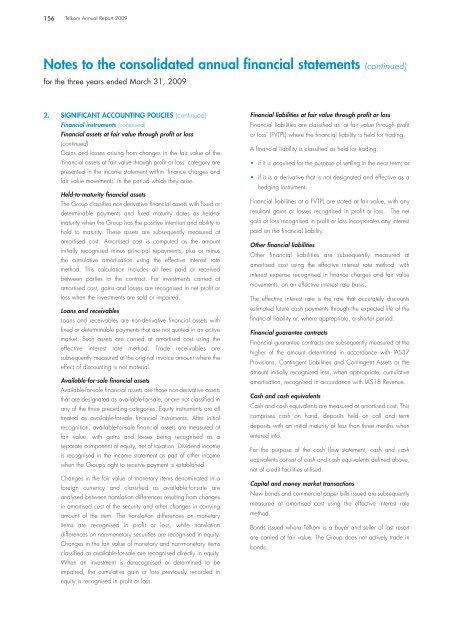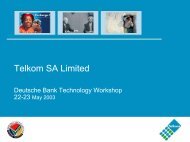Telkom AR front.qxp
Telkom AR front.qxp
Telkom AR front.qxp
You also want an ePaper? Increase the reach of your titles
YUMPU automatically turns print PDFs into web optimized ePapers that Google loves.
156<br />
<strong>Telkom</strong> Annual Report 2009<br />
Notes to the consolidated annual financial statements (continued)<br />
for the three years ended March 31, 2009<br />
2. SIGNIFICANT ACCOUNTING POLICIES (continued)<br />
Financial instruments (continued)<br />
Financial assets at fair value through profit or loss<br />
(continued)<br />
Gains and losses arising from changes in the fair value of the<br />
’financial assets at fair value through profit or loss’ category are<br />
presented in the income statement within ’finance charges and<br />
fair value movements’ in the period which they arise.<br />
Held-to-maturity financial assets<br />
The Group classifies non-derivative financial assets with fixed or<br />
determinable payments and fixed maturity dates as held-tomaturity<br />
when the Group has the positive intention and ability to<br />
hold to maturity. These assets are subsequently measured at<br />
amortised cost. Amortised cost is computed as the amount<br />
initially recognised minus principal repayments, plus or minus<br />
the cumulative amortisation using the effective interest rate<br />
method. This calculation includes all fees paid or received<br />
between parties to the contract. For investments carried at<br />
amortised cost, gains and losses are recognised in net profit or<br />
loss when the investments are sold or impaired.<br />
Loans and receivables<br />
Loans and receivables are non-derivative financial assets with<br />
fixed or determinable payments that are not quoted in an active<br />
market. Such assets are carried at amortised cost using the<br />
effective interest rate method. Trade receivables are<br />
subsequently measured at the original invoice amount where the<br />
effect of discounting is not material.<br />
Available-for-sale financial assets<br />
Available-for-sale financial assets are those non-derivative assets<br />
that are designated as available-for-sale, or are not classified in<br />
any of the three preceding categories. Equity instruments are all<br />
treated as available-for-sale financial instruments. After initial<br />
recognition, available-for-sale financial assets are measured at<br />
fair value, with gains and losses being recognised as a<br />
separate component of equity, net of taxation. Dividend income<br />
is recognised in the income statement as part of other income<br />
when the Group’s right to receive payment is established.<br />
Changes in the fair value of monetary items denominated in a<br />
foreign currency and classified as available-for-sale are<br />
analysed between translation differences resulting from changes<br />
in amortised cost of the security and other changes in carrying<br />
amount of the item. The translation differences on monetary<br />
items are recognised in profit or loss, while translation<br />
differences on non-monetary securities are recognised in equity.<br />
Changes in the fair value of monetary and non-monetary items<br />
classified as available-for-sale are recognised directly in equity.<br />
When an investment is derecognised or determined to be<br />
impaired, the cumulative gain or loss previously recorded in<br />
equity is recognised in profit or loss.<br />
Financial liabilities at fair value through profit or loss<br />
Financial liabilities are classified as ‘at fair value through profit<br />
or loss’ (FVTPL) where the financial liability is held for trading.<br />
A financial liability is classified as held for trading:<br />
• if it is acquired for the purpose of settling in the near term; or<br />
• if it is a derivative that is not designated and effective as a<br />
hedging instrument.<br />
Financial liabilities at a FVTPL are stated at fair value, with any<br />
resultant gains or losses recognised in profit or loss. The net<br />
gain or loss recognised in profit or loss incorporates any interest<br />
paid on the financial liability.<br />
Other financial liabilities<br />
Other financial liabilities are subsequently measured at<br />
amortised cost using the effective interest rate method, with<br />
interest expense recognised in finance charges and fair value<br />
movements, on an effective interest rate basis.<br />
The effective interest rate is the rate that accurately discounts<br />
estimated future cash payments through the expected life of the<br />
financial liability or, where appropriate, a shorter period.<br />
Financial guarantee contracts<br />
Financial guarantee contracts are subsequently measured at the<br />
higher of the amount determined in accordance with IAS37<br />
Provisions, Contingent Liabilities and Contingent Assets or the<br />
amount initially recognised less, when appropriate, cumulative<br />
amortisation, recognised in accordance with IAS18 Revenue.<br />
Cash and cash equivalents<br />
Cash and cash equivalents are measured at amortised cost. This<br />
comprises cash on hand, deposits held on call and term<br />
deposits with an initial maturity of less than three months when<br />
entered into.<br />
For the purpose of the cash flow statement, cash and cash<br />
equivalents consist of cash and cash equivalents defined above,<br />
net of credit facilities utilised.<br />
Capital and money market transactions<br />
New bonds and commercial paper bills issued are subsequently<br />
measured at amortised cost using the effective interest rate<br />
method.<br />
Bonds issued where <strong>Telkom</strong> is a buyer and seller of last resort<br />
are carried at fair value. The Group does not actively trade in<br />
bonds.




